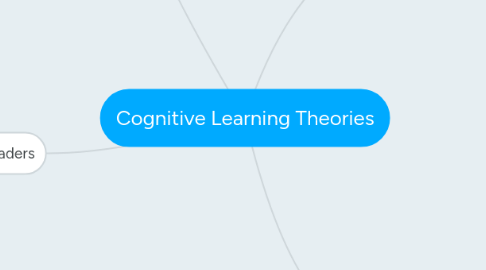
1. Individual Perspective
1.1. Cognitive development occurs when a learner can take past experiences and use those experiences to solve new problems, whether it be by using prior knowledge, or by building off of prior knowledge. There are certain stages learners must go through that are influenced by the environment, and dispositions, but that do not necessarily correlate to age.
2. Targeted Age: K- 2nd Graders
2.1. Applications
2.1.1. Starting each new lesson by brainstorming what children already know and what children what like to learn, as lesson progresses, children list what they have learned
2.1.2. Adding a time frame of each new lesson where children can work with and learn from each other in small groups
2.1.3. Incorporating "play" time into each lesson
2.2. Main Ideas
2.2.1. Vygotsky
2.2.1.1. Social Learning
2.2.1.1.1. Students can participate in groups to conduct learning exercises and complete assignments
2.2.1.2. Adult-Child Interaction
2.2.1.2.1. The teacher can use guided reading and modeling techniques to increase social interaction and learning in the classroom
2.2.2. Piaget
2.2.2.1. Zone of Proximal Development
2.2.2.1.1. Students are introduced to material that is neither too difficult or too easy to learn
2.2.2.2. Equilibrium
2.2.2.2.1. Repetition is encouraged via worksheets and review to ensure students are practicing applying new skills.
3. Compare and Contrast
3.1. Contrast
3.1.1. Vygotsky
3.1.1.1. Stages
3.1.1.2. Interaction with adults is the main source of learning
3.1.1.3. Children can only learn topics within a certain range (Zone of Proximal Development)
3.1.1.3.1. Even topics in the Zone of Proximal Development can only be accomplished with assistance through interaction
3.1.1.4. Formal and Informal Schooling are fundamental to learning
3.1.2. Piaget
3.1.2.1. Ages
3.1.2.2. Developmental stage is equally important as age as the main indicator of learning
3.1.2.3. Children learn by alternating between states of accessing existing schemes and needing to apply new schemes (Equilibrium)
3.1.2.3.1. Children must successfully move from equilibrium to disequilibrium, back to equilibrium in order to think in a more complex manner
3.1.2.4. The ability to explore and learn from social interactions are fundamental tolearning
3.2. Compare
3.2.1. Children learn in stages
3.2.2. Children must be introduced to tasks at the correct difficulty level in order to successfully learn
3.2.3. New tasks must allow learner to build from prior knowledge
4. 21st Century Evaluation
4.1. Piaget
4.1.1. A Neo-Piagetian theory has arisen, which refutes the idea that children learn in exact stages, however, accepts that children must learn based on some connection to their prior level of knowledge.
4.1.2. More hands-on opportunities are provided in classrooms as learning aids.
4.2. Vygotsky
4.2.1. Students are introduced to new topics based on the level at which they can comprehend, through a method of scaffolding.
4.2.2. Guided reading allows teachers to be influential to help readers at different levels, while also leaving room for growth.
